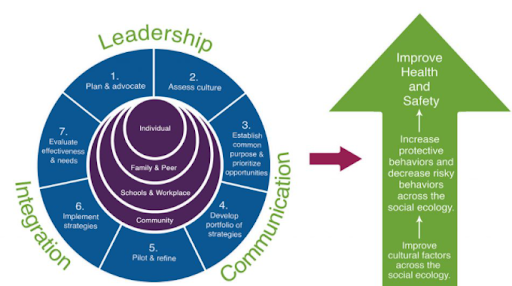
Top Five Takeaways from the Positive Culture Framework Training
By: Matt Erdel, Blaine County PFS
This month Prevention Specialists throughout the state of Montana had the chance to learn about the Positive Culture Framework (PCF). The PCF is an approach developed by the Center for Health and Safety Culture at Montana State University to help cultivate health and safety in organizations and communities. The PCF is based on the Center’s many past and ongoing research projects investigating how a cultural approach in prevention and public health affects traffic safety, substance abuse, and violence. Although the PCF offers a range of insights useful for Prevention Specialists as they build coalitions and implement programming in their communities, the training specially highlighted the role that the PCF has had in the development of ParentingMontana.org. What follows are one attendee’s Top Five Takeaways from learning about the PCF.
1) The value of an appreciative lens. Conversations about public health can often center fears and anxieties about an unhealthy behavior and associated beliefs. But fear is not a particularly effective way to promote a culture of health and wellbeing. The PCF invites public health leaders to focus on what kinds of positive beliefs and behaviors they want to grow in their communities. Accomplishing a reduction in certain risky behaviors is best achieved through the positive promotion of an inoculating belief or behavior.
2) Thinking across the social ecology. It is easy to focus on individual behavior when considering a public health problem. But prevention science and the PCF indicates it is important for communities and leaders to focus on systemic change rather than individual instances of a problematic behavior. Thinking across the social ecology recognizes the complex layers of interaction happening at various levels of our communities. Beliefs and behaviors don’t appear spontaneously, nor do they originate from a single source. They develop and change in layers of relationship (e.g., individual, family/peer, school/work/organization, and community levels), so all these layers in the broader environment should be addressed by prevention efforts.
3) Good social and emotional development is good prevention. Communities who invest in social and emotional development set their members up to flourish. Good mental, emotional, and behavioral development (MEB; sometimes referred to as Social Emotional Learning, or SEL) gives people skills to manage emotions, maintain healthy relationships, achieve goals, negotiate difference with empathy, and promote and protect meaning and self-identity. Good MEB health has cascading, multiplying, positive outcomes for individuals and communities, mitigating the harm of negative experiences and producing better outcomes across the lifespan.
4) The PCF complements existing prevention frameworks. The researchers and educators at the Center for Health and Safety Culture have developed the PCF such that it can be used as its own extensive process for communities and coalitions involved in prevention work. However, they recognize that coalitions are often already using other frameworks to structure their efforts (e.g., SAMHSA’s Strategic Prevention Framework). The PCF can be incorporated into other prevention frameworks, strengthening coalitions following the SPF or DFC models.
5) Effectiveness > Busyness. Repeated in almost every training session was a phrase attributed to self-help guru Stephen Covey: “Are we busy or are we effective?” Trainers and participants agreed it can be challenging to be intentional in our work activity, blocking out the busy items that can fill up to-do lists but don’t lead to cultivating healthier communities.
